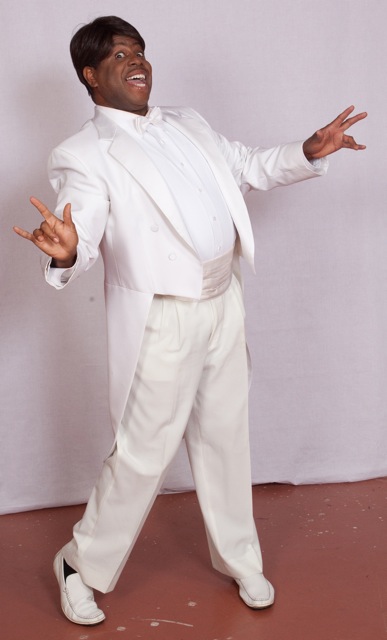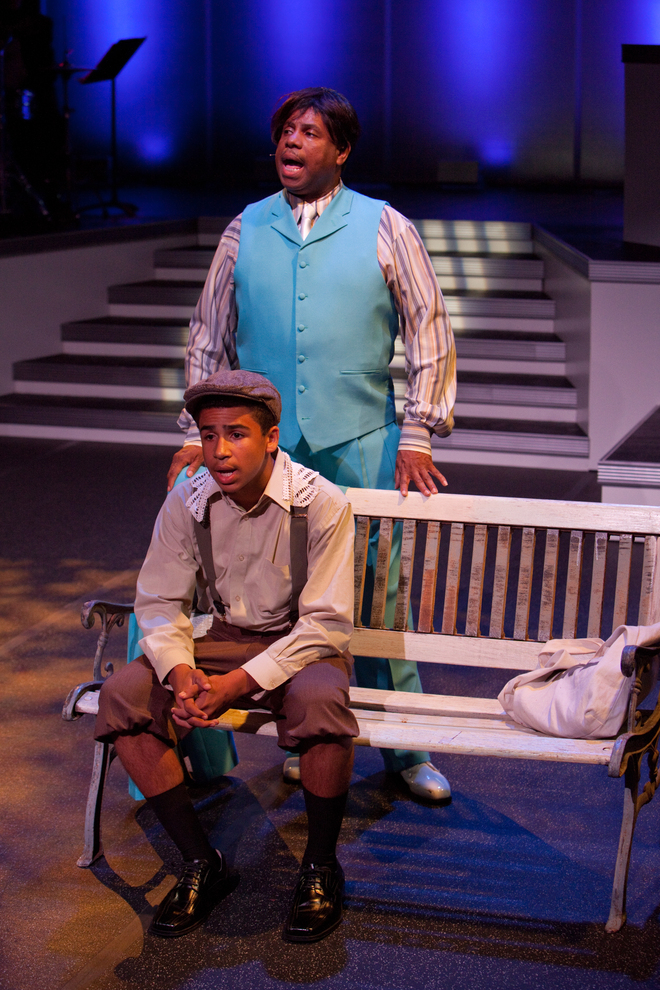LarryParr.info
02/24/17
HI-DE-HI-DE-HO
" There's A Boat Dats Leavin' Soon For New York" (Gershwin). Grand Prairie Uptown Theater.
YouTube - Monte Howell as Cab Calloway in The Cab Calloway Story at the Grand Prairie Uptown Theater.
Written by Larry Parr, Directed by Kevin Kratzke.
![]()
1 set
3 Actors
Adult Cab: African-American Actor
Young Cab: Teen-age African-American Actor
The Woman in Cab's Life: African-American Actress
SYNOPSIS
Cab Calloway was born on Christmas Day, 1907. His father suffered bouts of mental illness and was eventually hospitalized. He soon died, and Cab spent his life wondering what happened to his best friend.
Cab grew up rudderless but determined to help his mother with their bleak finances. Instead of attending school, he often hot-walked horses at Pimlico to earn extra money, or shined shoes, or sold newspapers on the streetcar. His personality attracted people to him, and he soon learned that the pretty girls in his school would do his studying for him. One pretty girl, Zelma Proctor, was special to him, and she ended up pregnant. Although he offered to marry her, Zelma was more level-headed than Cab, and she went away to New York to live with her aunt and have Cab’s first child, Camay Proctor.
His mother insisted that he attend college, to become a lawyer, although Cab’s first love was show business. He constantly cut classes to entertain in such Chicago nightclubs as Dreamland Cafe, where he met the great Louis Armstrong. Louis took Cab under his wing and taught him about singing and music.
He met Betty at Dreamland, who became his first wife, and he got together his first orchestra, who went on tour and ended up in New York. There, he enjoyed his meteoric rise to stardom at such places as The Cotton Club, and he became internationally known through records, Broadway, radio, and movies.
Cab flourished through the Great Depression and World War II, but at the end of the war, the big-band era ended, and Cab’s fortune fell away. He lost money betting on horses. At his lowest, he lived in a cheap hotel, not knowing where his next dime would come from, feeling alone. Although he had two daughters, he did not feel he was part of a family.
A call from a Broadway producer saved him, with the offer to play Sportin’ Life in a revival of PORGY AND BESS. Soon thereafter, he met Nuffie, the love of his life. After a struggle, he finally was divorced from Betty, and although he never had a father to teach him, he finally learned what love was about. Nuffie and Cab were together for the rest of his life, and they had three beautiful daughters. Cab was finally part of the family he craved.
HI-DE-HI-DE-HO is filled with the great songs that Cab
Calloway made famous --- REEFER MAN, AIN’T MISBEHAVIN’, MINNIE THE MOOCHER;
HOW BIG CAN YOU GET?, THERE’S A BOAT THAT’S LEAVIN’ SOON FOR NEW YORK; IT
AIN’T NECESSARILY SO, and many more.
What The Critics Say
“From the moment Jacobs appears onstage moving and
vocalizing to The Calloway Boogie, he’s got the audience ready to sing
along. When the band, under the direction of James Dodge II, rips into
Reefer Man, Minnie the Moocher or Everybody Eats
When They Come to My House, the evening puts you squarely back into the
heyday of the Cotton Club and Calloway’s prime.”
Kay Kipling.
The new musical play “Hi De, Hi De Ho! Cab Calloway,” reveals Cab
Calloway’s
personal demons – missing his father who died when Cab was a child, his love
of scotch, and troubled relationships with women.
This world premiere by the Westcoast Black Theatre Troupe, which
commissioned Parr’s play, provides an exciting biography.
There is the strength of a vibrant, energetic performance by
the troupe’s founder and artistic director, Nate Jacobs. And director Jim
Weaver keeps it entertaining and interesting.
With strong support from a four-person band led by musical
director James Dodge II, Jacobs tears through nearly two dozen songs, from
“It Don’t Mean a Thing if it Ain’t Got That Swing,” “Tiger Rag,” “Jazz Me
Blues,” “Everybody Eats When they Come to My House” and Calloway’s “Porgy
and Bess” hit “It Ain’t Necessarily So.”
Jay Handleman
Cab Calloway was arguably the most
celebrated singer, dancer, vaudevillian, bandleader of the Harlem
Renaissance of the 1930s and '40s Swing Era. In his early days, while
performing with the group, the Missourians, he was taken under the wing of
trumpeter Louis Armstrong, who turned Calloway's middle-class, choir-boy,
music-schooled voice into an icon of scat and jazz vocals. He is most known
for his songs, "Reefer Man" and "Minnie the Moocher," which sold over a
million copies. For many years he was the headliner for the famous Cotton
Club in Harlem where he replaced Duke Ellington. He electrified the packed
audiences with his showmanship, and his band became the top-grossing act of
the jazz era, introducing such talents as Dizzy Gillespie and Cozy Cole.
Award-winning playwright Larry Parr's plays, which include "Hi-Hat
Hattie" and "My Castle's Rockin'," have been successfully performed in
regional theaters throughout the country. This is the world premiere of "Hi
De, Hi De Ho! Cab Calloway."
The musical numbers were entertaining.
Nate Jacobs is well up to the part, famous white tuxedo and all, of
representing Calloway. He is endowed with a wonderful, almost too elegant
for scat, voice, and some smooth moves.
Paula Atwell.
Hi De, Hi De Ho! Cab Callaway at the Westcoast Black Theater
The WBTT rocked last night with the performance of Nate Jacobs as Cab
Calloway.
He maintained the vocal range, enthusiasm, energy, exuberance,
and style of the esteemed bandleader, vocalist, composer, author, and actor.
His body language and vocal range reincarnated Callaway through over twenty
musical numbers including his famous "Minnie the Moocher". He tells the
audience his scatting, random use of nonsense syllables and improvisation,
came about because he forgot the words. Callaway was a charismatic performer
with great style and flair. His dramatic dress, often white zoot suit and
tails, vitality, and perseverance kept him entertaining for over 60 years.
Nate Jacobs captured every bit of Callaway on stage for the entire
production with a zeal that never faltered. He was supported by Chris
Eisenberg (young Cab) whose vocal talent is exceptional and Jasmine
McAllister who played multiple roles with class and spirit in spite of a
foot injury which kept her confined to a high stool.
Vera
Greene.
Copyright © 2006 [TechieRN].
All rights reserved.
Revised: 02/24/17.
.jpg)

